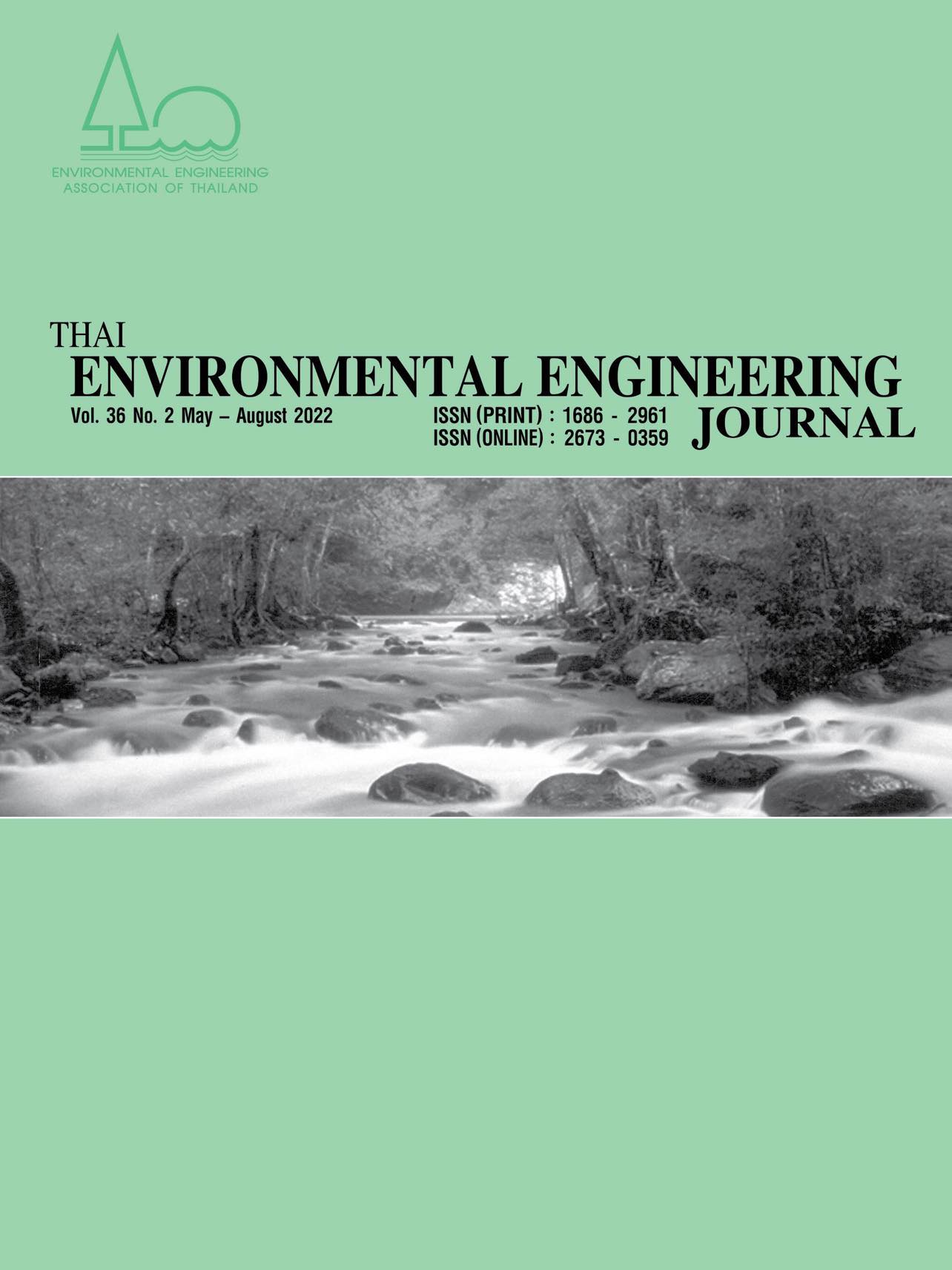DBPs Formation by Chlorination and Chloramination of Water and Treated Water at Short and Long Reaction Times
Main Article Content
Abstract
This work investigated disinfection by-products formation potential (DBPFP) by chlorination and chloramination. Raw water was collected from the U-Tapao canal, Songkhla, Thailand. This work used poly aluminum chloride (PACl) of 15 mg/L and aluminum chlorohydrate (ACH) of 1 percent w/v in coagulation experiments. DBPFPs were conducted on raw water and PACl-treated water and ACH-treated water at 1-day and 7-day reaction times. The raw water had a turbidity of 31.3 NTU and a DOC of 2.52 mg/L. The turbidity was reduced by PACl and ACH to levels below the water supply standard. DOC was reduced by 27 and 32 percent by PACl and ACH, respectively. The most prominent DBPFP found in chlorinated and chloraminated samples was trihalomethane formation potential (THMFP). THMFP levels of 171 and 425 µg/L were detected in the chlorinated raw water after 1-day and 7-day reaction times, respectively. In the chloraminated raw
water, THMFP of 4.7 and 8.5 µg/L were detected, respectively. At 1-day reaction time, iodo-trihalomethane formation potential (I-THMFP), haloacetronitrile formation potential (HANFP), and trichloronitromethane formation potential (TCNMFP) of the chlorinated raw water were higher than that of the chloraminated raw water. At 7-day reaction time, I-THMFP of the chlorinated raw water was higher than that of the chloraminated raw water. HANFP and TCNMFP of the chlorinated raw water were lower than that of the chloraminated raw water. PACl and ACH are capable of lowering DBPFP, particularly THMFP and I-THMFP, in chlorinated water and HANFP in chloraminaed water. For treated water at 1-day and 7-day reaction times, chlorination had a greater impact on THMFP and I-THMFP than chloramination. The HANFP of chlorinated samples was higher than that of chloraminated samples after 1-day reaction time, whereas the HANFP of chloraminated samples was higher than that of chlorinated samples after 7-day reaction time.
Article Details
References
Wang, Q.F., Shao, Y.S., Gao, N.Y., Liu, S.S., Dong, L., Rao, P.H., Chu, W.H., Xu, B., An, N. and Deng, J. 2020, Impact of zero valent iron/persulfate preoxidation on disinfection by-products through chlorination of alachlor, Chem. Eng. J. 380.
Phatthalung, W.N. and Musikavong, C. 2019, Emerging disinfection by-products' formation potential in raw water, wastewater, and treated wastewater in Thailand, Journal of Environmental Science and Health, Part A, 54(8): 2019. 745-758.
Musikavong, C., Srimuang, K., Tachapattaworakul, T. and Suksaroj, S.C. 2016. Formation of trihalomethanes of dissolved organic matter fractions in reservoir and canal waters. J. Environ. Sci. Health A. 51(9):782-791.
Goslan, E.H., Seigle, C., Purcell, D., Henderson, R., Parsons, S.A., Jefferson, B. and Judd, S.J. 2017. Carbonaceous and nitrogenous disinfection by-product formation from algal organic matter. Chemosphere. 170:1-9.
Zhai, H., He, X., Zhang, Y., Du, T., Adeleye, A.S. and Li, Y. 2017. Disinfection byproduct formation in drinking water sources: A case study of Yuqiao reservoir. Chemosphere. 181: 224-231.
Schwarz. 2005. Directed assistance module no. 4 chloramine disinfection and dbp control.
Poleneni, S.R. 2020. Recent research trends in controlling various types of disinfection by products in drinking water: detection and treatment. Disinfection By-produtcs in Drinking Water. 337-370.
He, J., Wang, F., Zhao, T., Liu, S. and Chu, W. 2020. Characterization of dissolved organic matter derived from atmospheric dry deposition and its DBP Formation. Water Research 171: 115368.
Sitham, K., Choonual, T., Musikavong, C. and Sinyoung, S. 2022. Utilizing Polyaluminum Chloride (PACl) and Aluminum Chlorohydrate (ACH) for Treating Raw Water and DBPs Formation, Suranaree J. Sci Technol, In press.
Musikavong, C. and Wattanachira, S. 2013. Identification of dissolved organic matter in raw water supply from reservoirs and canals as precursors to trihalomethanes formation, Journal of Environmental Science and Health. Part A. 48: 2013. 760-771.
Keawchouy, S. 2021. Treatment of silver nanoparticles microplastic and disinfection by-products in raw water from U-Tapao canal by coagulation and membrane filtration, Master Thesis, Prince of Songkla University.
Zhang, T-Y., Lin, Y-L., Xu, B., Cheng, T., Xia, S-J., Chu, W-H. and Gao, N-Y. 2016. Formation of organic chloramines during chlor (am)ination and UV/chlor(am)ination of algae organic matter in drinking water. Water Research. 103:189-196.
APHA. 1998. Standard Methods for the Examination of Water and Wastewater, 20th Ed.; American Public Health Association, AWWA and WEF: Washington DC. 1998.
Louisiana Department of Health, Chloramination Recommendations For Public Water Systems That Chloraminate : 1-3.
US.EPA. 2003. Determination of chlorination disinfection by-products, chlorinated solvents, and halogenated pesticides/herbicides in drinking water by liquid-liquid extraction and gas chromatography with electron-capture detection, Methods 551.1. Office of research and development, Cincinnati, Ohio 45268. USA.
Song, H., J.W., Addison., Hu, J. and Karanfil, T. 2010. Halonitromethanes formation in wastewater treatment plant effluents. Chemosphere 79: 174-179.
Provincial Waterworks Authority. 2011. Water supply standard according to WHO year 2011.
Jaichuedee, J., Wattanachira, S., Musikavong, C. 2020. Kinetics of the formation and degradation of carbonaceous and nitrogenous disinfection by-products in Bangkok and Songkhla source water. Science of the Total Environment. 708: 134888.
Sakai, H., Tokuhara, S., Murakami, M., Kosaka, K., Oguma, K. and Takizawa, S. 2015. Comparison of chlorination and chloramination in carbonaceous and nitrogenous disinfection byproduct formation potentials with prolonged contact time.


